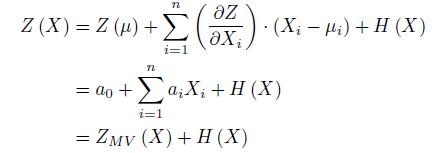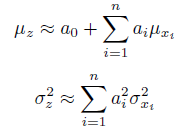NESSUS Mean Value [1]
Mean Value is the most basic analytical method and takes very few model evaluations. Mean Value method is based only on the derivatives of the response function at the mean of the design variables.NESSUS uses finite difference approximations to estimate the gradients. This method may be used to get an idea of the probability of failure but the value should not be considered accurate as this method does not try to converge on an MPP and should not be depended upon for complex problems. Since this method is gradient based it may not be appropriate for noisy or discontinuous response functions. This method depends on linear state approximation of the limit state function at the MPP so the probability value computed could be in error for highly non-linear limit state functions. Thus this method can be accurate only if the response function is a linear function of the design variables. If the model can have failed runs this method should not be used because of it gradient nature. This method should not be used with discrete design variables or discrete response variables. Multiple local MPPs may induce error in the probability estimation by this method and that error tends to be most pronounced for large probabilities of failure.
The method assumes that the Z-function is smooth and Taylor's series expansion of Z exists at the mean values of the design variables. Thus the Z-function is then expressed as:

where the derivatives are evaluated at the mean values of the design variables. ZMV represents the sum of the first-order terms and H(X) represents the higher order terms. The coefficients ai are computed by numerical differentiation method. The minimum number of evaluations required is 1 greater than the number of design variables. Thus as this is a first order approximation technique we ignore higher order terms and then the mean and standard deviation of Z, assuming independent random variables can be approximated as:

These two statistical moments can be computed easily after the coefficients ai are computed. Thus for non-linear Z-functions the Mean Value solution is not sufficiently accurate. The AMV+ method should thus be always preferred to Mean Value method as it tries to converge on an MPP.
Control Parameters
| Name | Default Value | Description |
|---|---|---|
| Finite Difference Step Size | 0.01 | This option is used to calculate finite difference step size. The step sizes are determined based on the value of this option multiplied by the mean value of the design variable. Thus if the mean value of the design variable was 5 and the finite difference step size option had the value of 0.1, the actual step size would be 0.1*5 = 0.5. The step size is used by the underlying optimizer trying to locate the MPP. The option expects a value typically within 0 and 1. |
References:1. NESSUS Theoretical Manual, February 17, 2012, Section 8.1